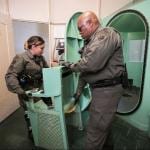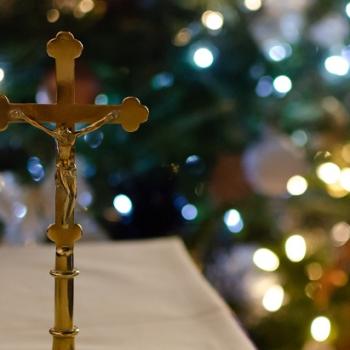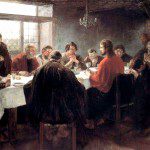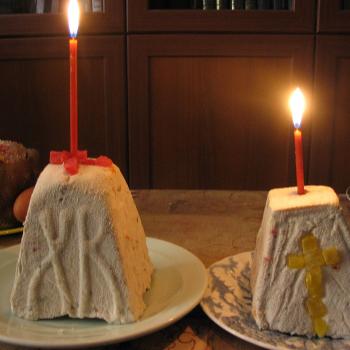I spent Easter weekend participating in events commemorating the 20th anniversary of the shootings at Columbine High School, which sits twenty miles from my home. Tension filled the air around Denver as the anniversary approached. Half a million students were kept home from school as the FBI and local law enforcement searched for a young woman who, infatuated with Columbine, flew in from Florida and bought a pump-action shotgun and ammunition, sparking fears of another incident.
The mass murder at Columbine, one of the first such events captured on live television, opened a rift in modern society. Some 43 copycat perpetrators worldwide have cited Columbine as the inspiration for their own assaults. I spoke at a memorial service that took place on Maundy Thursday, the day schools reopened after the young woman from Florida was found dead with a self-inflicted wound. Uniformed policemen met us at the doors of the church, while their undercover counterparts milled among the crowd, looking for signs of trouble.
All week, local media had been broadcasting interviews with Columbine survivors. It was a shock to see the familiar names and faces, teenagers frozen in time from 1999, now middle-aged adults with children of their own. Reporters noted that, on entering the studio, most of the survivors first checked for the nearest Exit signs, a protective instinct carried over from their high school days.
I was in Florida on April 20, 1999, watching in horror as the Columbine events played out. Exactly eight years later I received a call from a student leader in Blacksburg, Virginia. “No doubt you’ve heard of the shootings at Virginia Tech,” he said. “You wrote a book called Where Is God When It Hurts. That’s the only question we’re asking here. Could you possibly come and speak to us on that topic?”
I agreed, and brought with me Kacey Ruegsegger Johnson, a Columbine survivor permanently disabled by a shotgun blast into her shoulder at close range. She knew what the Tech students were going through. “When you return home, everyone will want you to put behind you what happened, and get over it,” she told them. “You need to know that you never will. You’ll live with it the rest of your lives.” I first heard from Kacey the phrase “a new normal,” which has since become part of survivors’ vocabulary. Indeed, in the wake of Columbine and so many other mass shootings, our entire nation has entered a somber new normal.
A grief pastor at a megachurch in Denver later told me he learned an important lesson while SCUBA diving. “You can go very deep with the proper equipment. But the deeper you go, the slower you must come to the surface, adjusting to the change in pressure. I’ve found that Christians, especially, aren’t very skilled at handling grief. We want the grieving person to get past it. We offer platitudes and pat answers, such as ‘Everything happens for a reason.’ We need to learn a lesson from Job’s friends, who sat with him in silence for seven days and nights. It was when they opened their mouths that the problems started. Jews still ‘sit shiva’ for seven days, like Job’s friends. They understand that after a traumatic event, there’s a place for lament, for sorrow, for a ‘communion of grief.’”
Columbine survivors have told me that trauma never completely disappears. It surges back each time another school shooting makes the news, or when they see a man in a trench coat, or hear a car backfire.
Columbine students often asked their principal, Frank DeAngelis, “Will it ever get better?” Yes, he answered, “but it’s a marathon, not a sprint. It takes time.” DeAngelis, who recently published his story in the book They Call Me Mr. De, led the long process toward healing. Defying death threats, he promised to stay on the job until every student in the Columbine school district graduated, thirteen more years. When the last kindergartner graduated, a parent called and said, “What about my son—he was enrolled in a two-year pre-school program? So the principal stayed two more years, past retirement age.
Early on, DeAngelis met with families weekly, and scheduled regular “days of service” for Columbine students to give back to their community. As Kacey Ruegsegger Johnson told me, “Community made all the difference here. The students at Virginia Tech scattered, back to their homes, and lost the support of those around them who had shared the tragedy. We’re a tight community. I’d go to the grocery store with my arm in a sling and people would surround me with love and support. We never felt alone.”
Columbine families met weekly for eighteen months to plan a new school library, named Hope, to replace the one where the main attack occurred. As years went by, one survivor started a Sandy Hook-Columbine Cooperative to reach out to the devastated families in Newtown, Connecticut. Frank DeAngelis joined the I Love You Guys foundation to minister to a school in a nearby county which also experienced a shooting. Heather Martin began The Rebels Project, named for the Columbine school mascot, to bring counseling and support to other victims of school and workplace shootings. Rachel Scott’s father founded Rachel’s Challenge to replace bullying with kindness and respect.
At the memorial service, two Columbine survivors, Crystal Woodman Miller and Patrick Ireland, gave stirring testimonies, and Principal DeAngelis and a popular teacher openly talked about how their faith had sustained them. It began to sound more like a revival service than a memorial, and afterward I jokingly asked the teacher, Tom Tonelli, if everyone at Columbine was an outspoken Christian. He laughed, “It sometimes seems that way. But I can’t imagine getting through an event like that without God’s strength to rely on.”
If I have learned one thing about tragedy, it is this: God is on the side of the sufferer. “The Lord is close to the brokenhearted and saves those who are crushed in spirit,” says the psalmist. The apostle Paul suggests how: “the God of all comfort…comforts us in all our troubles, so that we can comfort those in any trouble with the comfort we ourselves receive from God.”
Makoto Fujimura, the renowned artist and director of the Culture Care Initiative at Fuller Seminary’s Brehm Center, presented the school with a painting he had begun twenty years before, when he first heard about the Columbine tragedy. He also contributed a Kintsugi bowl from Japan. “The original noodle bowl is from the 17th century,” he explained, “almost five hundred years old. It broke, and in the Kintsugi tradition it lay in pieces until the 19th century. Then craftsmen painstakingly pieced it together, sealing its broken seams with pure gold.
“Repaired, the bowl became far more beautiful, and valuable, than it had ever been, and even now it can hold water without leaking. I give this ancient bowl to Columbine High School as a symbol of the forward-looking repair that is in process. Rivers of gold can run through our brokenness. Generations from now, the descendants of Columbine survivors will have this as a visible reminder that something beautiful can come from great sadness.”
The Kintsugi bowl evokes the biblical pattern of redemption. The prophet Jeremiah wrote, “A voice is heard in Ramah, mourning and great weeping, Rachel weeping for her children and refusing to be comforted, because they are no more.” To express the trauma of Israel after invasions by Assyria and Babylon, he seized on the image of a national mother figure losing her child—exactly what the parents of Columbine students experienced in 1999. How could God allow a tragedy? How could any good come from it? Yet out of that trauma came the Hebrew Bible, or Old Testament, as scribes recorded the long history of God’s involvement with their nation.
Six centuries later, Matthew echoed that prophecy to express the grief of mothers who lost their children in Herod’s Massacre of the Innocents. Again Rachel wept for her children, although Herod failed to eradicate his main target: Jesus’ family, like Israel, went into exile. Later, Herod’s political successors succeeded where he had failed, executing Jesus in what seemed the end of the Galilean’s movement. What appeared at the time as the darkest day of history, the murder of God’s own Son, turned into the triumph of Easter and a day we now call Good Friday.
“I never would have imagined that the worst thing that ever happened to me could truly be turned into something positive,” Crystal Woodman Miller told us at the memorial service. “Out of evil, good may come. Out of tragedy, hope may come. I think it’s no accident that the twentieth anniversary of Columbine takes place on Holy Saturday, a day of utter despair. But we believe in a God who is in the business of resurrection!”
As one family told me after the service, “We came tonight with anxiety, especially after the scare that took place in Denver this week. Part of us wanted to stay away, to avoid the memories. But we leave this church inspired and uplifted. The scars will never go away. But our hearts are full of hope.”
“Where is God when it hurts?” the Virginia Tech student asked me after the tragedy there. I saw the answer among the survivors of a similar tragedy just down the road from my home. God is in God’s people, reaching out to bring comfort and hope. Columbine, a place known around the world as a center of tragedy, is also a place of resilience and redemption. A place where pain and love converge.













